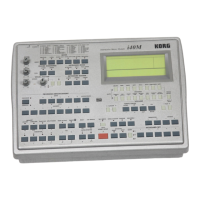Getting Started • MIDI
44
5. MIDI
What is MIDI?
The MIDI protocol. The MIDI is a standard protocol
that defines the hardware and software for the com-
munication between musical instruments and comput-
ers. The hardware is represented by the interface with
multipolar connectors located on the back of the i40M.
The connectors are:
• MIDI IN (to receive data),
• MIDI OUT (to send data)
• MIDI THRU (to re-transmit the data received over
the MIDI IN).
The MIDI IN 1 and MIDI IN 2 connectors of the i40M
are identical. As a rule, if only one instrument is con-
nected, it is recommended to use the MIDI IN 1 con-
nector.
The software of the MIDI protocol is represented by a
series of “messages” that the controller instrument
(master) sends to the controlled instrument (slave) to
“instruct” it to emit a sound or somehow modify it.
For example, if a MIDI keyboard is connected to the
i40M, pressing a key on the keyboard will cause the
transmission of a note activation message (Note On).
The message will go through one of the MIDI channels
and reach the i40M, that will convert the note message
into a sound.
The same occurs with other messages: fox example,
pressing the sustain pedal will cause the transmission
of the Sustain/Damper message; editing the volume
will cause the transmission of the Volume message,
and so on.
The MIDI messages. There are “general” MIDI mes-
sages (metronome tempo, Start/Stop, Local Off) and
“channel” messages that only refer to one of the six-
teen MIDI channels.
The channel messages include the Note On (note acti-
vation), Program Change (selection of program,
arrangement, Keyboard Set), and Control Change.
Most of the control messages, such as Sustain/Damper
and Volume, is sent in the form of a Control Change
message. This message consists in two parts: the Con-
trol Change number (0-127), that determines the con-
trol type, and the control value (0-127).
For instance, the activation of the Sustain/Damper
pedal is a Control Change #64, with value 127. A
“standard” volume is a Control Change #07, with
value 90.
Some important controllers are:
The list of the messages sent via MIDI can be found in
the Appendix.
Connections. In order to connect two musical instru-
ments, you need standard MIDI cables that can be
found in any musical instrument store.
Each cable must be used to connect two connectors of
different instruments. Never connect two connectors
of the same instrument with the same cable.
The simplest connection is the connection between the
MIDI OUT connector of the controller and the MIDI
IN connector of the controlled instrument.
The MIDI channels. The MIDI messages are sent from
one instrument to the other over 16 separate channels.
Each message must be sent over a specific MIDI chan-
nel.
For example, if the keyboard transmits over channel 1,
the controlled instrument must receive over channel 1.
If not, the controlled instrument will not play or will
play the sound of a different channel.
The special channels. Some MIDI channels of the
i40M can be assigned to “special channels” that are
used for special functions. These channels are Global,
Chord 1, Chord 2, Arrangement and Keyboard Set. A
detailed description of these channels is contained in
the following pages.
CC# Name Notes
00 Bank Select MSB
In combination with CC#32 selects
the program bank. In the i40M its
value is always 0.
01 Modulation Activates modulation.
07 Volume Selects volume.
10 Pan Selects the pan value.
32 Bank Select LSB
In combination with CC#00, selects
the program bank. In the i40M the
possible values are:
Banks A-B = 00
Banks C-D = 01
Bank E = 02
Bank F = 03
Bank Dr = 04
91 Effect 1 send Effect 1 send
93 Effect 2 send Effect 2 send

